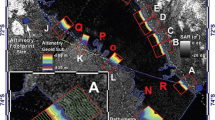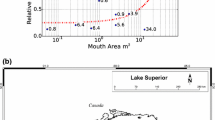Abstract
The natural modes of Ontario Lacus surface oscillations, the largest lake in Titan’s southern hemisphere, are simulated and analyzed as they are potentially of broad interest in a variety of dynamical researches. We found that tidal forces are too low in frequency to excite the (barotropic) normal modes. Broadband wind forcing likely spans the resonant frequencies. High wind speed, which could be encountered under episodic phenomena such as storms, would be required to significantly excite the normal modes. While the slower baroclinic normal modes could more easily be resonantly forced by the low-frequency tidal forces, addressing this issue demands unavailable information about the lake stratification.







Similar content being viewed by others
Notes
Imaging Science Subsystem: it takes pictures in visible, near-ultraviolet, and near-infrared light (see Porco et al.2004).
The solar longitude of Saturn, Ls, is the angle between the sun and Saturn and describes the season of Saturn and its moons.
The former concern the motion of a constant density liquid and are mostly external modes, i.e. approximately depth-dependent, while the latter differently impacts each layer of various density, resulting in internal oscillations.
A fundamental slosh is a normal mode with 1 node in the domain, i.e. it is the longest standing wave that can be observed in the domain.
Reprinted from Transient surface liquid in Titan’s polar regions from Cassini, 211, Hayes, A. G.; Aharonson, O.; Lunine, J. I.; Kirk, R. L.; Zebker, H. A.; Wye, L. C.; Lorenz, R. D.; Turtle, E. P.; Paillou, Philippe; Mitri, G and others, 655–671, Copyright (2011), with permission from Elsevier
These equations are obtained by separation of variables.
The mass matrix results from the integral of the product of the shape functions over each element of the domain.
The maximum wind speed is set to 1 m/s in accordance with existing data and atmospheric model results.
References
Aharonson O, Hayes AG, Lunine JI, Lorenz RD, Allison MD, Elachi C (2009) An asymmetric distribution of lakes on Titan as a possible consequence of orbital forcing. Nat Geosci 2(12):851–854. https://doi.org/10.1038/ngeo698
Atreya SK, Adams EY, Niemann HB, Demick-Montelara JE, Owen TC, Fulchignoni M, Ferri F, Wilson EH (2006) Titan’s methane cycle. Planet Space Sci 54(12):1177–1187. https://doi.org/10.1016/j.pss.2006.05.028
Baretta-Bekker HJ, Duursma EK, Kuipers BR (1998) Encyclopedia of marine sciences. Springer Science & Business Media
Bernard PE, Deleersnijder E, Legat V, Remacle JF (2008) Dispersion analysis of discontinuous Galerkin schemes applied to Poincaré, Kelvin and Rossby waves. J Sci Comput 34(1):26–47. https://doi.org/10.1007/s10915-007-9156-6
Brown RH, Soderblom LA, Soderblom JM, Clark RN, Jaumann R, Barnes JW, Sotin C, Buratti B, Baines KH, Nicholson PD (2008) The identification of liquid ethane in Titan’s Ontario Lacus. Nature 454 (7204):607–610. https://doi.org/10.1038/nature07100
Charnay B, Barth E, Rafkin S, Narteau C, Lebonnois S, Rodriguez S, Du Pont SC, Lucas A (2015) Methane storms as a driver of Titan’s dune orientation. Nat Geosci 8(5):362. https://doi.org/10.1038/ngeo2406
Cordier D, Mousis O, Lunine JI, Lavvas P, Vuitton V (2009) An estimate of the chemical composition of Titan’s lakes. Astrophys J Lett 707(2):L128. https://doi.org/10.1088/0004-637X/707/2/L128
Cornet T, Bourgeois O, Le Mouélic S, Rodriguez S, Gonzalez TL, Sotin C, Tobie G, Fleurant C, Barnes J, Brown R et al (2012) Geomorphological significance of Ontario Lacus on Titan: integrated interpretation of cassini VIMS, ISS and RADAR data and comparison with the Etosha Pan (Namibia). Icarus 218 (2):788–806. https://doi.org/10.1016/j.icarus.2012.01.013
Coyette A, Baland RM, Van Hoolst T (2018) Variations in rotation rate and polar motion of a non-hydrostatic Titan. Icarus 307:83–105. https://doi.org/10.1016/j.icarus.2018.02.003
De Jong M, Battjes J (2004) Low-frequency sea waves generated by atmospheric convection cells. J Geophys Res-Oceans 109:C1. https://doi.org/10.1029/2003JC001931
Dermott SF, Sagan C (1995) Tidal effects of disconnected hydrocarbon seas on Titan. Nature 374 (6519):238–240. https://doi.org/10.1038/374238a0
Geuzaine C, Remacle JF (2009) Gmsh: a 3-d finite element mesh generator with built-in pre-and post-processing facilities. Int J Numer Methods Eng 79(11):1309–1331. https://doi.org/10.1002/nme.2579
Hartwig JW, Colozza A, Lorenz RD, Oleson S, Landis G, Schmitz P, Paul M, Walsh J (2016) Exploring the depths of Kraken Mare–power, thermal analysis, and ballast control for the Saturn Titan submarine. Cryogenics 74:31–46. https://doi.org/10.1016/j.cryogenics.2015.09.009
Hayes AG (2016) The lakes and seas of Titan. Annu Rev Earth Pl Sc, 44
Hayes AG, Aharonson O, Callahan P, Elachi C, Gim Y, Kirk RL, Lewis K, Lopes R, Lorenz RD, Lunine JI et al (2008) Hydrocarbon lakes on Titan: distribution and interaction with a porous regolith. Geophys Res Lett 35:9. https://doi.org/10.1029/2008GL033409
Hayes AG, Wolf AS, Aharonson O, Zebker H, Lorenz RD, Kirk RL, Paillou P, Lunine JI, Wye L, Callahan P et al (2010) Bathymetry and absorptivity of Titan’s Ontario Lacus. J Geophys Res-Planet 115:E9. https://doi.org/10.1029/2009JE003557
Hayes AG, Aharonson O, Lunine JI, Kirk RL, Zebker HA, Wye LC, Lorenz RD, Turtle EP, Paillou P, Mitri G et al (2011) Transient surface liquid in Titan’s polar regions from Cassini. Icarus 211 (1):655–671. https://doi.org/10.1029/2009JE003557
Hayes AG, Lorenz RD, Lunine JI (2018) A post-cassini view of Titan’s methane-based hydrologic cycle. Nat Geosci 11:306–313. https://doi.org/10.1038/s41561-018-0103-y
Hussmann H, Choblet G, Lainey V, Matson DL, Sotin C, Tobie G, Van Hoolst T (2010) Implications of rotation, orbital states, energy sources, and heat transport for internal processes in icy satellites. Space Sci Rev 153(1–4):317–348. https://doi.org/10.1007/s11214-010-9636-0
Jones E, Oliphant T, Peterson P, et al. (2001) SciPy: open source scientific tools for Python. http://www.scipy.org/ [Online; accessed May 2018]
Lebonnois S, Burgalat J, Rannou P, Charnay B (2012) Titan global climate model: a new 3-dimensional version of the IPSL Titan GCM. Icarus 218(1):707–722. https://doi.org/10.1016/j.icarus.2011.11.032
Lorenz RD (1994) Crater lakes on Titan: rings, horseshoes and bullseyes. Planet Space Sci 42(1):1–4. https://doi.org/10.1016/0032-0633(94)90134-1
Lorenz RD, Tokano T, Newman CE (2012) Winds and tides of Ligeia Mare, with application to the drift of the proposed time TiME (Titan Mare Explorer) capsule. Planet Space Sci 60(1):72–85. https://doi.org/10.1016/j.pss.2010.12.009
Lorenz RD, Turtle EP, Barnes JW, Trainer MG, Adams DS, Hibbard KE, Sheldon CZ, Zacny K, Peplowski PN, Lawrence DJ et al (2018) Dragonfly: a rotorcraft lander concept for scientific exploration at Titan. Johns Hopkins APL Technical Digest
Lunine JI, Hayes A, Aharonson O, Mitri G, Lorenz R, Stofan E, Wall S, Elachi C, Team CR et al (2009) Evidence for liquid in Ontario Lacus (Titan) from Cassini-observed changes. In: AAS/Division for planetary sciences meeting abstracts# 41, vol 41
Mastrogiuseppe M, Poggiali V, Hayes A, Lorenz R, Lunine J, Picardi G, Seu R, Flamini E, Mitri G, Notarnicola C et al (2014) The bathymetry of a Titan sea. Geophys Res Lett 41(5):1432–1437. https://doi.org/10.1002/2013GL058618
Mastrogiuseppe M, Hayes A, Poggiali V, Seu R, Lunine JI, Hofgartner J (2016) Radar sounding using the Cassini altimeter: waveform modeling and Monte Carlo approach for data inversion of observations of Titan’s seas. IEEE T Geosci Remote 54(10):5646–5656. https://doi.org/10.1109/TGRS.2016.2563426
Mastrogiuseppe M, Hayes AG, Poggiali V, Lunine JI, Lorenz R, Seu R, Le Gall A, Notarnicola C, Mitchell KL, Malaska M et al (2018) Bathymetry and composition of Titan’s Ontario Lacus derived from Monte Carlo-based waveform inversion of Cassini RADAR altimetry data. Icarus 300:203–209. https://doi.org/10.1016/j.icarus.2017.09.009
Merian J (1828) Ueber die bewegung tropfbarer flüssigkeiten in gefässen [on the motion of drippable liquids in containers]. PhD thesis PhD thesis. Basel, Schweighauser
Mitchell JL, Ádámkovics M, Caballero R, Turtle EP (2011) Locally enhanced precipitation organized by planetary-scale waves on Titan. Nat Geosci 4:589–592. https://doi.org/10.1038/ngeo1219
Mitri G, Coustenis A, Fanchini G, Hayes AG, Iess L, Khurana K, Lebreton JP, Lopes RM, Lorenz RD, Meriggiola R et al (2014) The exploration of Titan with an orbiter and a lake probe. Planet Space Sci 104:78–92. https://doi.org/10.1016/j.pss.2014.07.009
Porco CC, West RA, Squyres S, Mcewen A, Thomas P, Murray CD, Delgenio A, Ingersoll AP, Johnson TV, Neukum G et al (2004) Cassini imaging science: instrument characteristics and anticipated scientific investigations at Saturn. Space Sci Rev 115(1-4):363–497. https://doi.org/10.1007/s11214-004-1456-7
Rodriguez S, Le Mouélic S, Rannou P, Sotin C, Brown R (2013) Six years of continuous observation of Titan cloud activity with Cassini/VIMS. In: SF2A-2013: Proceedings of the annual meeting of the French society of astronomy and astrophysics, pp 71–74
Sagan C, Dermott SF (1982) The tide in the seas of Titan. Nature 300(5894):731–733. https://doi.org/10.1038/300731a0
Sauter S, Wittum G (1992) A multigrid method for the computation of eigenmodes of closed water basins. Impact Comput Sci Eng 4(2):124–152. https://doi.org/10.1016/0899-8248(92)90019-5
Sotin C, Hayes AG, Malaska MJ, Nimmo F, Trainer M, Mastrogiuseppe M, Soderblom JM, Tortora P, Hofgartner JD, Aharonson O, Barnes JW, Hodyss R, Iess L, Kirk RL, Lavvas P, Lorenz RD, Lunine JI, Mazarico E, McEwen AS, Neish C, Nixon CA, Turtle EP, Vuitton V, Yelle R (2017) Oceanus: a new frontiers orbiter to study Titan’s potential habitability. In: 48th Lunar and planetary science conference, lunar and planetary science conference, vol 48, p 2306
Stofan ER, Elachi C, Lunine JI, Lorenz RD, Stiles B, Mitchell KL, Ostro S, Soderblom L, Wood C, Zebker H et al (2007) The lakes of Titan. Nature 445(7123):61–64. https://doi.org/10.1038/nature05438
Tokano T (2010) Simulation of tides in hydrocarbon lakes on Saturn’s moon Titan. Ocean Dyn 60(4):803–817. https://doi.org/10.1007/s10236-010-0285-3
Tokano T, Lorenz RD (2015) Wind-driven circulation in Titan’s seas. J Geophys Res-Planet 120(1):20–33. https://doi.org/10.1002/2014JE004751
Tokano T, Lorenz RD, Van Hoolst T (2014) Numerical simulation of tides and oceanic angular momentum of Titan’s hydrocarbon seas. Icarus 242:188–201. https://doi.org/10.1016/j.icarus.2014.08.021
Turtle E, Perry J, Barbara J, Del Genio A, Rodriguez S, Le Mouélic S, Sotin C, Lora J, Faulk S, Corlies P et al (2018) Titan’s meteorology over the Cassini mission: evidence for extensive subsurface methane reservoirs. Geophys Res Lett 45(11):5320–5328. https://doi.org/10.1029/2018GL078170
Turtle EP, Perry JE, Hayes AG, McEwen AS (2011) Shoreline retreat at Titan’s Ontario Lacus and Arrakis Planitia from Cassini imaging science subsystem observations. Icarus 212(2):957–959. https://doi.org/10.1016/j.icarus.2011.02.005
Ventura B, Notarnicola C, Casarano D, Posa F, Hayes AG, Wye L (2012) Electromagnetic models and inversion techniques for Titan’s Ontario Lacus depth estimation from Cassini RADAR data. Icarus 221 (2):960–969. https://doi.org/10.1016/j.icarus.2012.09.011
Vienne A, Duriez L (1991) A general theory of motion for the eight major satellites of Saturn. II-Short-period perturbations. Astron Astrophys 246:619–633
Vienne A, Duriez L (1992) A general theory of motion for the eight major satellites of Saturn. III-Long-period perturbations. Astron Astrophys 257:331–352
Vienne A, Duriez L (1995) TASS1 6: Ephemerides of the major Saturnian satellites. Astron Astrophys 297:588
Vincent D, Karatekin Ö, Vallaeys V, Hayes AG, Mastrogiuseppe M, Notarnicola C, Dehant V, Deleersnijder E (2016) Numerical study of tides in Ontario Lacus, a hydrocarbon lake on the surface of the Saturnian moon Titan. Ocean Dyn 66(4):461–482. https://doi.org/10.1007/s10236-016-0926-2
Vincent D, Karatekin Ö, Lambrechts J, Lorenz RD, Dehant V, Deleersnijder É (2018) A numerical study of tides in Titan’s northern seas, Kraken and Ligeia Maria. Icarus 310:105–126. https://doi.org/10.1016/j.icarus.2017.12.018
Wall S, Hayes AG, Bristow C, Lorenz RD, Stofan ER, Lunine JI, Le Gall A, Janssen M, Lopes R, Wye L et al (2010) Active shoreline of Ontario Lacus, Titan: a morphological study of the lake and its surroundings. Geophys Res Lett 37(5):L05, 202. https://doi.org/10.1029/2009GL041821
Webb D (2013) On the shelf resonances of the English Channel and Irish Sea. Ocean Sci 9(4):731–744. https://doi.org/10.5194/os-9-731-2013
Funding
Computational resources were provided by the Consortium des Équipements de Calcul Intensif (CÉCI), funded by the Belgian Fund for Scientific Research (F.R.S.-FNRS) under Grant No. 2.5020.11. Eric Deleersnijder is an honorary Research associate with the F.R.S.-FNRS. This research is funded by the Belgian PRODEX, managed by the ESA, in collaboration with the Belgian Federal Science Policy Office.
Author information
Authors and Affiliations
Corresponding author
Additional information
Responsible Editor: Pierre F.J. Lermusiaux
Rights and permissions
About this article
Cite this article
Vincent, D., Lambrechts, J., Karatekin, Ö. et al. Normal modes and resonance in Ontario Lacus: a hydrocarbon lake of Titan. Ocean Dynamics 69, 1121–1132 (2019). https://doi.org/10.1007/s10236-019-01290-2
Received:
Accepted:
Published:
Issue Date:
DOI: https://doi.org/10.1007/s10236-019-01290-2




